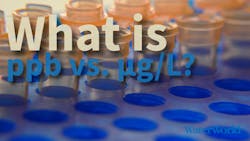What are parts-per-billion (ppb) and micrograms-per-liter (µg/L)?
Parts-per is a set of scientific units used to describe small values within a solution.
Similarly, x-per-liter is used to define small values within a solution, but for the International System of Units (SI).
What is parts-per-billion (ppb)?
Parts-per-billion (ppb) is part of a set of units in science and engineering used to describe small values.
The parts-per notation is typically used in chemistry. For example, the relative quantity of dissolved minerals or pollutants in water. These fractions have no associated units of measurements and are quantity-per-quantity measures.
This notation is not part of the SI system.
For example, the quantity 1 ppb can be used for a fraction if a water-borne pollutant is present at one-billionth of a gram per gram of sample solution.
This would look like 0.000000001 grams of pollutant per one gram of solution.
For perspective, parts-per-million (ppm) would look like 0.000001 grams of pollutant per one gram of solution.
Part-per-trillion, which is the unit the U.S. Environmental Protection Agency (EPA) used to set limits on some PFAS molecules, would look like 0.000000000001 grams of pollutant per one gram of solution.
The EPA set maximum contaminant levels (MCLs) of 4 ppt for PFOA and PFOS. This would be 4-12 or 0.000000000004 grams of pollutant per one gram of solution.
What is an example of parts-per-billion (ppb)?
If PFOA in drinking water is 10 ppb, it means there are 10 parts of PFOA per billion parts of water.
The EPA MCL for PFOA is 4 ppt, or 0.004 ppb.
What is micrograms-per-liter (µg/L)?
Micrograms-per-liter (µg/L) is part of a set of units in science and engineering used to describe small values for the SI system. Micrograms utilizes the letter mu (µ) from the Greek alphabet to describe micro in its abbreviation.
This unit is often used to measure contaminants, nutrients and pollutants in drinking water, wastewater and natural water bodies.
Although the liter is not an official SI unit, it may be used with SI prefixes.
Whereas parts-per is a volume-to-volume or mass-to-mass ratio, µg/L is a mass-to-volume relationship.
For example, µg/L translates to 0.000001 (10-6) g of pollutant in 1 liter of solution.
For perspective, milligrams-per liter would look like 0.001 (10-3) g of pollutant per 1 liter of solution.
What is an example of micrograms-per-liter (µg/L)?
If lead in drinking water is measured at 10 µg/L, that means there are 10 micrograms of lead in each liter of water.
The U.S. EPA’s action level for lead in drinking water is 15 µg/L.
What is the difference between parts-per-billion (ppb) and micrograms-per-liter (µg/L)?
The difference between parts-per-billion (ppb) and micrograms-per-liter (µg/L) depends on the context in which they are used, but in water measurement they are often equivalent.
1 ppb is equal to 1 µg/L because 1 liter of water weighs approximately 1 kilogram.
According to the Hawaii Water Resources Research Center (WRRC), they are basically the same. Micrograms-per-liter (µg/L) are sometimes referred to as parts-per-billion (ppb) in aqueous solutions because there are 1 billion micrograms in 1 liter.
They key difference between the two is that ppb is a dimensionless ratio (mass-to-mass or volume-to-volume ratio), whereas µg/L is a mass-to-volume ratio.
About the Author
Alex Cossin
Associate Editor
Alex Cossin is the associate editor for Waterworld Magazine, Wastewater Digest and Stormwater Solutions, which compose the Endeavor Business Media Water Group. Cossin graduated from Kent State University in 2018 with a Bachelor of Science in Journalism. Cossin can be reached at [email protected].

